From merchandising to manufacturing, design is more than a creative process at Culp Home Fashions — it’s a collaborative, artistic affair.
Merchandising includes all the nonverbal tactics that retailers use for presenting and promoting their goods in-store, according to website Fit Small Business.
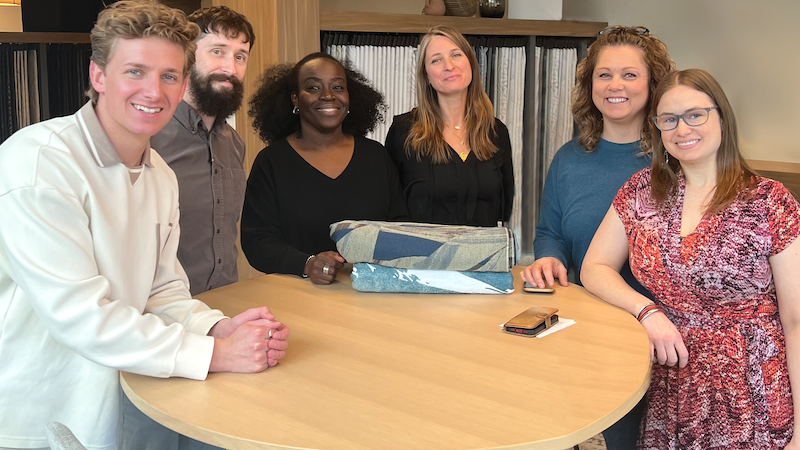
This includes your store layout, the products you sell, how you arrange them and even your pricing strategy. Merchandising can also
cultivate brand image, improve customer experience and drive sales.
But some mattress merchandising starts at the supplier level — in this case, at Culp Home Fashions. As the adage goes, “The eye buys,” and Culp’s ticking outfits beds in an enticing fashion that attracts customers to give them a try.
Hunter Morton, Culp Home Fashions concept designer of merchandise, brings a background in fashion and retail to his merchandising approach. “I get the privilege of organizing everything that our talented design team does,” Morton says. “So, my skill is to merchandise the product in a creative yet effective way that is aesthetically pleasing and also easy to navigate for our cross-functional sales partners.”
A newbie to the industry, Morton is known to “shake things up,” according to Christina Pennant, director of design and merchandising for Culp Home Fashions. “One of Hunter’s strengths is to look at things in a different way,” she says. “Sometimes we can be a little cookie cutter, if you will, but he will not bring the cookies to his merchandising.”
The wow factor
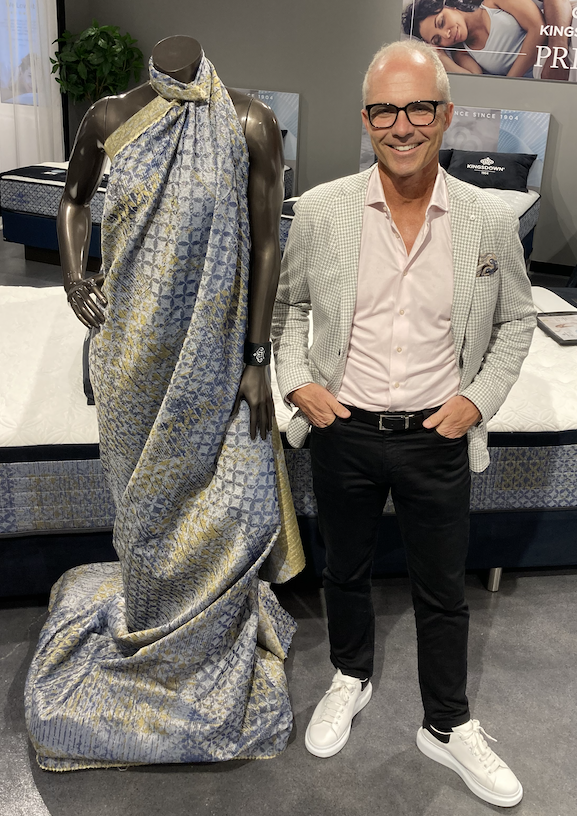
Morton’s fashion and retail background helps him anticipate customers’ preferences. “We do this by tracking trends and observing customer behavior,” he says. “I like to try and push people to take bold risks. The mattress industry can get stuck in a white and blue color palette. So, it’s always a joy to try and push customers in a bold, creative direction.”
“But it’s also exciting to take the approach of helping them build out their existing brand image and how their own personal taste works alongside Culp’s offering of fabrics,” he adds. “Observing customers and what they wear is helpful and dictates how far we can push them.”
Case in point: Mike James, the chair of mattress producer Kingsdown, headquartered in Mebane, North Carolina. James is known for his bold choices when it comes to mattress borders and embellishments. “We work with Mike, who’s a very fashionable person,” Morton says. “So, I know to bring out the wow factor.”
James recently introduced boiled wool tapes, handles and bases to Kingsdown’s Vintage Couture collection. Many of the company’s mattress borders are influenced by fashion: A man’s pocket square inspired the Passions collection, and one of his wife Natalie’s dresses inspired the Prime collection.
“When I walk into a mattress store, if my eye doesn’t immediately go to a Kingsdown mattress, then I’ve failed,” James has said.
On the retail floor, customers see the mattress borders first; and then as they approach the bed, they see the top panel. “Having an impactful border is something that can help you stand out,” Morton says. “Having those conversations with our manufacturing customers is a really enjoyable experience, to put together the outfit of the bed for them.”
Other mattress makers let Culp steer their design direction. “They say, ‘You guys are the experts. You tell us what is going to sell and capture the attention of customers on the retail floor,’” Morton says.
Culp’s Senior Stylist Tanja Tusa points out that today, many mattresses are bought online. “A lot of fabric needs to be photogenic,” Tusa says. “If you can’t see it online, you’re losing those customers.”
Morton agrees. “Some customers like to get away from white because most web pages are white, so their fabric doesn’t stand out; it blends in,” he says.
Designer handwriting
Morton and Tusa are part of Culp’s talented design team, and it is Pennant’s job to keep them engaged and inspired.
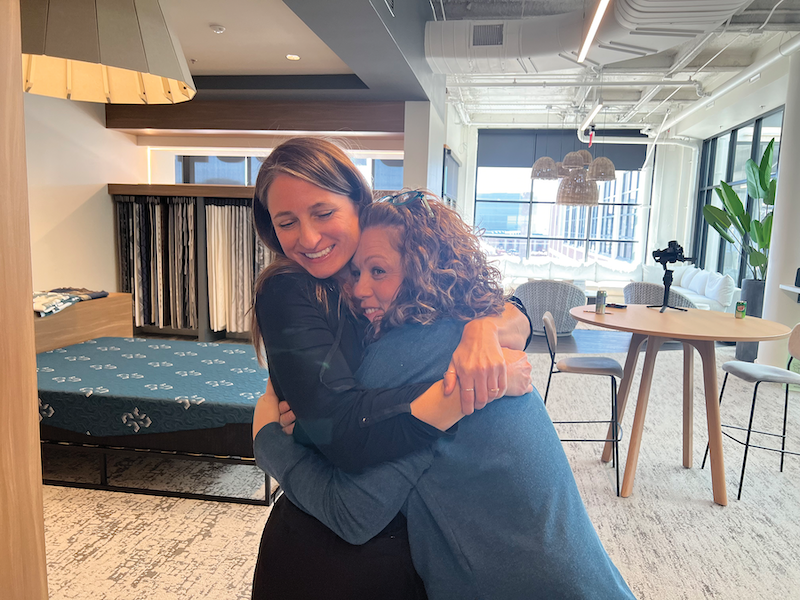
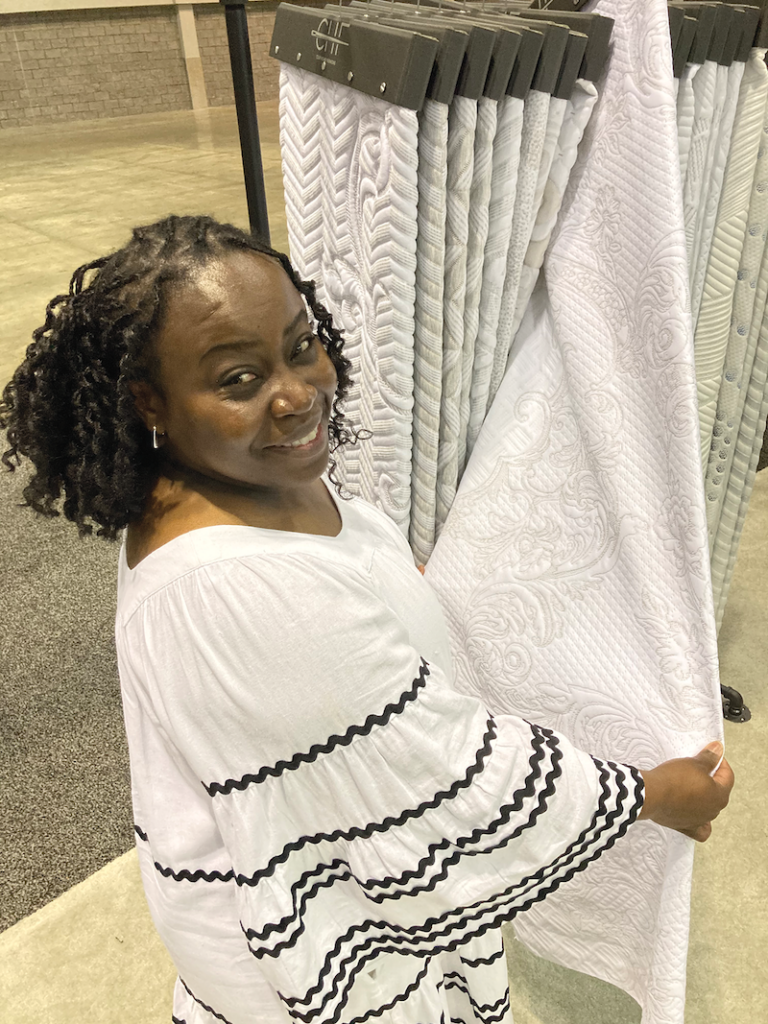
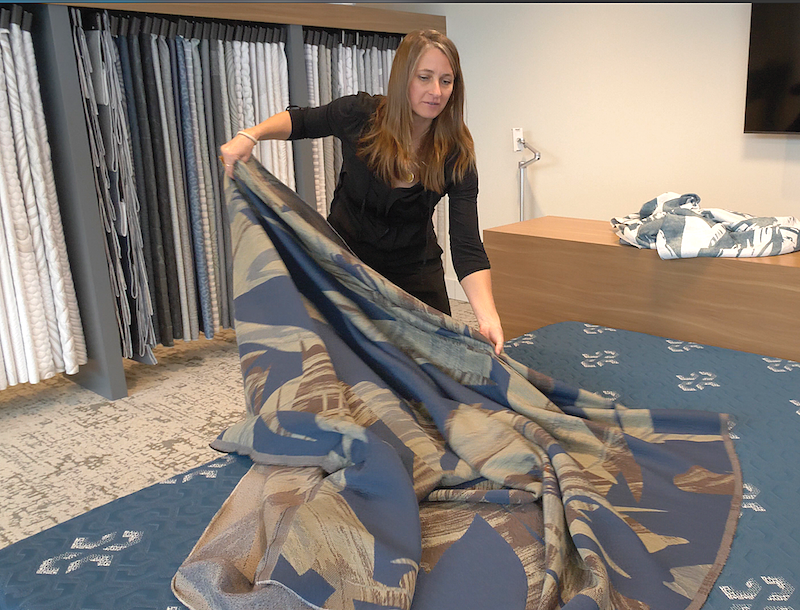
“I lean into the designer’s strengths, and it goes back to their handwriting (their own individual design style),” Pennant says. “Each one on my team brings a different attribute. So, I lean into that for inspiration.”
Take Tara Bulla, a designer with Culp for 25 years. She knows what it takes to make a fabric shimmer.
“When we think of handwriting and inspiring, when Tara creates her works of art, she tacks colorways that create brilliant gradients,” Pennant says. “She can make fabric shimmer and have this halo effect, and it may not have one drop of lurex (metallic thread) in it.”
Greta Speer, a Culp designer for six years, adds that Bulla, like herself, leans toward performance fabric and athletic textures, with a strength in technical designing.
“Greta is also a great problem-solver,” Tusa adds. “When something doesn’t work out, she actually enjoys trying to find a solution.”
Tusa, a Culp designer for 11 years, says her strength is trying new things. “If I don’t push the envelope, then we’ll never come up with something new,” she says. “But the problem with that is there are issues, and so I will lean on Greta to help me solve them.”
Miah Bryant, assistant textile designer, is one of the newest members of the team, on board for three years. “I like fine-tuning and detail,” Bryant says.
“With Miah being newer to the industry, she’s a sponge in that she soaks up everything from the design team and our merchandising team,” Pennant says. “And I think that’s what helps create a fresh approach.”
Philip Burger, senior concept artist at Culp, blends the conceptual and the digital. “I work between being very abstract and also pushing things digital and improving that kind of presence,” Burger says.
Digital advancements
Just as the designers complement each other, they also help one another navigate the industry’s challenges, such as becoming more digitally advanced (as seen in Culp’s new SoHo collection, which it describes as a line “for those who enmesh with the digital world and embrace bold choices”).
Four years ago, Culp began working with Imagine.io (formerly Live Furnish) to create digital 3D renderings. “It allows us to take simulations of fabric and then map them on bed models,” Burger says. “You can get a better idea of what your final product is going to look like and how it pairs with different borders and what it looks like in a space.”
Bulla chimes in: “Before, it was all done by hand, and it took hours. We’ve been doing mattress renderings and models and mock-ups for many years, but it was all by hand in Photoshop. And now this program allows our customers to interface with it.”
For Tusa, Imagine.io is a creative tool. “What’s nice is you can start mixing and matching,” she says. “Before, we didn’t have actual simulations of our fabric where it was in 3D, and you couldn’t see the loft.
“Now you can try different colors of the same fabric, and you can say, ‘Oh, what does this border look like? What if we put in a different gusset? So, you can build your outfit on the bed with your panel, your gusset, your border, your tapes, your foundation before investing in actually having to make it, so it saves money, it saves time and it expands the creativity.”
Burger points out that Imagine.io also helps Culp reduce the number of fabric samples, which leads to another benefit — reducing the company’s carbon footprint because it makes and transports less fabric.
Sustainable focus
Adding a strong selling story to its fabrics, Culp uses sustainable yarns such as Tencel, Econyl, Repreve and Seaqual. “Repreve is one of my favorites because we use it in the inlay, so you can use it in any fabric,” Bulla says. “You don’t have to redesign or change your color SKU to fit it in.”
At ISPA EXPO in March, the company unveiled its Zero collection. The new line tells a natural story by minimizing environmental impact. Its yarns and technology focus on low impact and circularity, with designs that evoke a feeling of blending with nature.
“We used a lot of Tencel in our Zero collection because it has such a nice hand; it is a really lovely yarn with its closed loop system,” Tusa says. “I personally love it, and I also love cottons, and we do offer organic cottons.”
Morton adds that some mattress companies have a tremendous organic sustainability story. “Culp has fabrics for them, as well as anybody else that wants to enter that world of Zero or sustainability,” he says. “We can meet requirements on all levels.”
In addition, the Culp Home Fashions factory is moving toward zero waste and recycles everything in the building. “We have no waste; everything has a home,” Pennant says. “If it leaves us, it will go to adult shelters for the homeless, so we just keep giving back.”
In February, Culp conducted its first Spread the Warmth initiative by sewing mattress fabric remnants into blankets and donating more than 250 blankets to local charities that work with the homeless.
Brand experience and heritage
Unlike some ticking companies, Culp employs brand experience managers to help with the creative design process. “We have an extremely intimate relationship with our brand experience team,” Pennant says. “The goal of the team is to live, breathe, eat and sleep the brand.
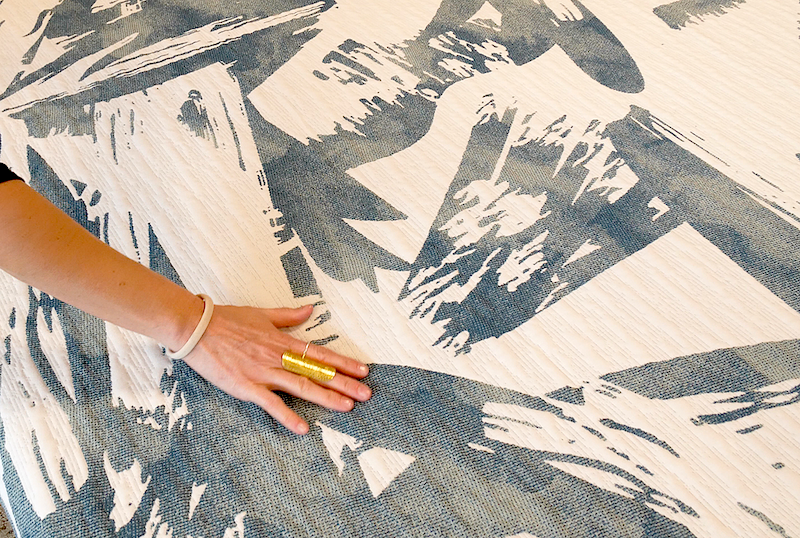
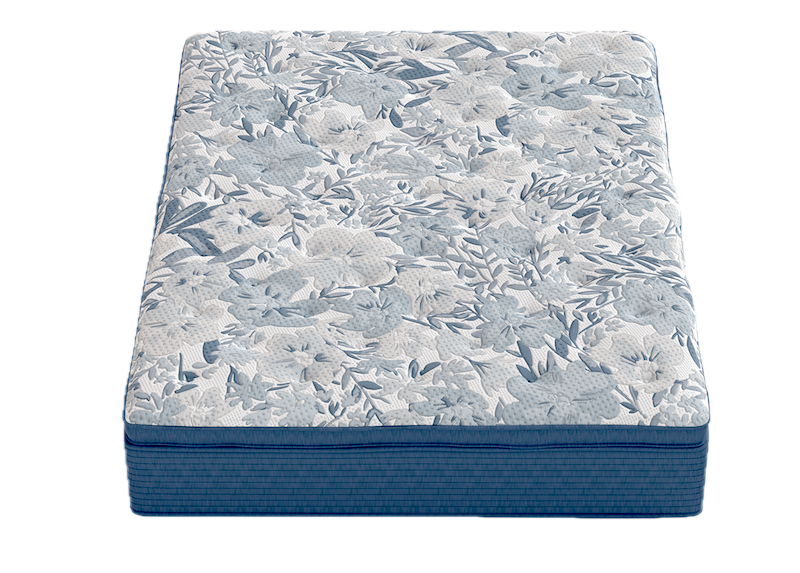
“We have some customers that are leading brand retailers and manufacturers, and the brand experience managers work intimately with them to garner every piece of information to get from point A to point Zed and bring it to the design team.”
Even more helpful, some brand experience managers are former designers. “They have a design language and can speak a language that we can interpret and understand,” Bulla says. “So, when they come to us with a project or descriptions, we have a better grasp of what is needed.”
Another key differentiator is Culp’s heritage, starting as R.G. Culp & Associates in 1972 making fabrics for the upholstery industry. Today, Culp is a publicly traded, international fabric company known for its fashion-driven business focusing on product innovations and new collections.
“We’ve been around for a long time,” Bulla says. “And the longevity speaks to our ability to make customers happy. We work with our customers — not make customers work with us. We try to make our products meet their needs. We try to innovate … with whatever they’re needing. We try to achieve whatever form or fashion that takes.”
Culp also encompasses other divisions, such as upholstery and cut and sew, with capabilities in wovens, covers and borders. “We can do everything vertically from making fabric to finishing the cover, with almost all the parts of the cover with our wovens,” Tusa says.
“And we’re not about being just a mattress company,” Pennant adds. “We have a lot of talent in every single corner of every building. … Culp in totality has a lot to offer.”
Bulla sums it up: “I’ve been here for 25 years, and this is my family. … We want to do beautiful things and to be original and creative. … But we’re a family, we have a greater purpose.”
Want to see more? Check out our private tour of Culp Home Fashion: Culp Home Fashions Design Tour: Beds By Design Takes You Inside.







